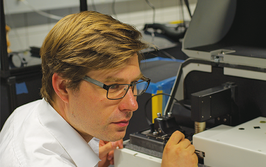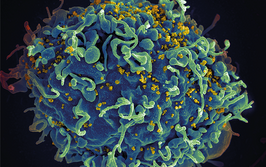Joining Forces: Powerful Proteomics
Collaboration between academia and instrument manufacturers not only pushes analytical science forward faster, it’s also good for the soul. In our new “Joining Forces” article series, we tell stories of teamwork – from the initiating spark to the ultimate objective. Our first installment delves into an ambitious proteomics project from the University of Cambridge, the Francis Crick Institute, and SCIEX.
Markus Ralser, Mark Cafazzo |

Tell us about your project…
Markus Ralser: It’s a collaboration between my lab, the lab of Kathryn Lilley (Cambridge Centre for Proteomics) and SCIEX. In my lab, we try to understand the interactions between metabolism and gene expression; we want to understand how cells react to changes in their environment and their nutrients, and how they change the breakdown of those nutrients. Kathryn’s lab is proteomics-focused – her role in this project is to contribute knowledge about different approaches to measure and identify proteins. SCIEX is the industry partner, developing technology and providing the instruments and technical know-how.
We work specifically with budding yeast, a small fungus that is a very important model organism in the biomedical sciences – easy to cultivate and informative. We have collections with several thousands of systematically generated yeast strains; ultimately, we want to use SCIEX technology and the expertise of both labs to measure changes in the proteome in all of those strains, and so find out how the genes function. Of course, that has to be a collaborative effort, as it requires skills from several disparate disciplines – no individual can solve such big problems alone.
Mark Cafazzo: We’re really excited about the work we’re doing with the Ralser lab – and pleased that they think our technology is the right tool to get the job done. It’s a great example of how we can work together and how public–private partnership advances the science. It’s an incredibly ambitious project...
MR: It certainly is! It sounds simple – “measuring 5,000 proteomes” – but it is actually a big endeavor. Even with all the effort and money that has gone into research of biological systems so far, we have only uncovered the tip of the iceberg. Up to now, we have tried to cut the biological system into minimal units and study them one by one, but that isn’t working. Imagine you have a car, and you chop it down, with one scientist studying the wheel, another one studying the key and the next one studying the window – it’s very hard to get a complete picture. But as -omics sciences develop, we get an increasingly good overview of how the pieces function together as an entire system.
What are the main benefits of collaboration between academia and industry?
MC: Securing government or grant funding is increasingly competitive. Often, our academic customers find value in partnering with someone in industry for these larger projects, so they can show that there is more than a purely academic interest – there is benefit to the industry, a benefit to the field of research that it’s addressing, and ultimately a benefit to society.
From our perspective, the value comes from working with labs that are doing cutting-edge work – it’s a big part of how analytical tool providers do business, especially within academia.
The researchers at the University of Cambridge and the Crick Lab are known in the field of proteomics and metabolomics for their high-quality research. Their work will further the science of proteomics and lead to a better understanding of disease, which is a fundamental need in this age of precision medicine. That’s why it’s important to us to support them, whether that’s direct support, collaborative support or the expertise we have with our own application scientists or R&D specialists when it comes to developing software. Collaborations are a great way for industry to stay directly in touch with thought leaders and get valuable feedback to better design products for the future.
MR: When developing a prototype, the engineers who build a mass spec may never use it. Unless you have it up and running and see it working on a daily basis, you can’t always know what problems to expect. By collaborating with us, they are not just putting the instrument in the lab, they are developing it alongside us – and that results in better technology.
For us in academia, there’s another factor to consider. We have a lot of young students in our labs, postdocs and PhD students; very few of them will find a job in academia. The sooner our students can make contacts with industry, the better the job they can get in a few years’ time. It also helps us get things done much more quickly – academia can be so slow. Industry is more money-driven, whereas we are problem-driven. On the other hand, it’s sometimes good for them to see that money isn’t everything! Both sides can profit considerably.
How did you build the partnership?
MC: It started with a direct relationship. We got to know the scientists, and it became clear that not only were they customers of SCIEX, but they saw value in using our instrumentation and software to address the challenges in their research. We often develop these kinds of relationships over the course of several years. We may eventually partner with someone in academia and use their input to develop a new product, or get their advice on a beta-product, or give them early access to something that hasn’t reached the commercial stage yet.
MR: We’ve actually worked together for quite a few years now – SCIEX has developed a number of technologies that we use to measure how cells behave and change. These are highly experimental instruments, so we get prototypes in the lab and don’t know exactly how we will use them. They run a lot of very complicated background software. We spend a lot of time with SCIEX engineers, working out problems that they may not have anticipated.
What challenges have you encountered?
MR: If you have a collaboration where three labs are working in parallel on the same problem, then of course things develop in different directions. This project is a three-way collaboration but we have a clear and defined goal, and this makes life much easier. We do have technical challenges, of course, and I can’t always predict how we will solve them – but this is the fun of collaboration – gathering knowledge and overcoming problems together.
MC: Our main challenge is that we don’t have unlimited resources, so we always have to justify the work we’re doing. There is a need for us to capture benefits for SCIEX from a collaboration like this. It can be tangible and specific, such as a co-written peer-reviewed journal article, or the work being used in marketing materials such as application notes or webinars. We also have to balance the number of collaborations we commit to – we can’t possibly collaborate with everybody, so we have to be judicious about which opportunities we select. From the collaborator or researcher’s side, the timelines they have in mind may not line up with development cycles, when the availability of certain products might be, and so on – but you just have to work together to find the most beneficial combination.

What makes a collaboration effective?
MC: First and foremost, agreement on the goals of the project and the value that both sides of the collaboration can recognize. The other thing is clear team communication. When we work with a collaborator – especially when it’s more than one lab and multiple scientists involved – you have to have a good coordinated effort. There has to be scientific leadership on both sides so that everyone can agree on the project milestones, and there has to be a certain amount of project management.
MR: This particular collaboration works well because we have a clear plan. First, we need to cultivate the yeast, then we need to grow, handle and measure, and in parallel develop the algorithms to analyze the data. It’s exciting to work in this setting, between industry and academia, as the worlds collide – it brings you out of your own niche and informs how your work evolves.
Principal Investigator at University of Cambridge and the Francis Crick Institute.
Mark Cafazzo, Director of Global Academic/Omics Business at SCIEX.

















